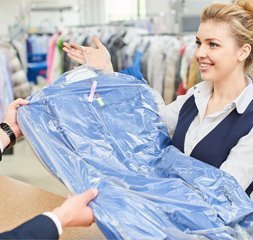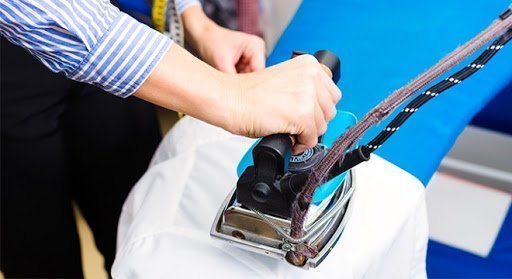Cabriole Home carries out dry cleaning works with the institutions they cooperate with. We closely monitor how these institutions conduct their business and offer them to our valued customers at the most affordable prices.

Textile products and garments for dry cleaning are carefully examined before receiving them from the customer. While information is taken from the customer about the determined stains, the customer is informed about the deformations in the fabric, if any.
Since cleaning processes are carried out according to the label instructions, the most appropriate cleaning process is decided by examining the maintenance symbols on the product. The product owner is informed about the products that are not suitable for the dry cleaning process or where the dry cleaning process is suspected, and the process to be performed on the product is determined according to the result of this information.
Clothing and textile products that are numbered so that they do not mix with other products are then grouped according to their color. Some textile paints are “loose” (the main responsible for this is red), and the manufacturers will run dye when they are immersed in the dry cleaning solvent because they do not perform the necessary tests. These are not dry cleaned with light-colored laundry in order to prevent color contamination. Therefore, light and dark colored fabrics are left in separate baskets after being grouped.
Necessary interventions are made for the products left in the cleaning basket by pre-stain removal using professional stain removers on the cabin stain tables.
Pre-stain removal process; It can provide complete removal of the stains as well as the preparation stage for the dry cleaning process. In the meantime, if there are any spots or deformations that are not noticeable in the first control phase, the relevant product owner is informed by phone.
The clothes examined on the stained table (including binding items such as zippers, snaps, buttons) are once again checked to see if they are suitable for dry cleaning.
It is also checked whether there are foreign objects in the clothes. Objects such as plastic pens can dissolve in the dry cleaning solvent bath, causing damage to the laundry that cannot be removed. Some ornamental binders are either not resistant to the dry cleaning solution or cannot withstand mechanical cleaning action in the dry cleaning machine, as the necessary tests are not carried out by the manufacturer. These are removed and re-sewn after dry cleaning or protected with a small quilted protector. Filled with bedspreads or tassels, etc. Dry cleaning is done after placing it in a bag with plenty of holes.

A dry cleaning machine is a combination of a washing machine used in the home and a dryer. Garments are placed in a wash/centrifuge chamber (called basket or drum) that forms the core of the dry cleaning machine. The washing chamber includes a horizontal and perforated drum that rotates in an outer chamber.
Outer partition; The spinning drum includes the solvent used during dry cleaning; it contains the products to be dry cleaned. Basket or drum, depending on the size of the dry cleaning machines, is approximately 10-40 kg. has a capacity between.
During the washing cycle, the drum chamber is filled with approximately 1/3 of the solvent and rotates to turn the laundry upside down. In the meantime, the solvent temperature in the drum of the dry cleaning machine is maintained at 30 degrees.
The solvent is then sent to a condensing unit containing a purification vessel and condenser. The condensed solution is sent to a separation unit and the water remaining in this unit is separated from the dry cleaning solvent and the dry cleaning solvent separated from the water is transferred to the 'clean solvent' tank.
A normal wash cycle is done in 8-15 minutes, depending on the type of garments and degree of soiling. During the first three minutes, the soluble dirt dissolves in perchloroethylene and comes out. It takes an additional three minutes to dissolve settled, difficult dirt. The washing cycle of machines using a hydrocarbon solvent is done for at least 25 minutes due to the slower dissolution of dirt.
At the end of the wash cycle, the machine starts a rinse cycle, and the clothes loaded on the dry cleaning machine are rinsed with fresh purified solvent from the clean solvent tank. Rinsing with this clean solvent prevents the dirt from absorbing from the "dirty solvent" onto the surface of the clothes.
The dry cleaning machine starts the centrifugation process after the rinse cycle. In this process, the dry cleaning solvent is recovered for reuse. Modern dry cleaning machines recover approximately 99.99% of the solvent used.
The centrifuge cycle is done by draining the solvent in the washing chamber and accelerating the basket at 350-450 revolutions per minute; As a result, most of the solvent is removed from the fabric during centrifugation. Then the dry cleaning machine switches to the drying cycle.
In the drying cycle, the garments are turned upside down in a recirculating hot air stream (63 ° C / 145 ° F), and the dry cleaning solvents remaining after the centrifuge cycle are evaporated. Then, the hot air discharged from the machine passes through a cooling unit; In this unit, the dry cleaning solvent is evaporated and condensed and returned to the purified solvent tank. New generation dry cleaning machines benefit from a closed-loop system. In this system, the cooled air is reheated and recirculated. As a result, the recovery of the dry cleaning solvent increases, and less air pollution is created. In the early days of dry cleaning, a large amount of perchloroethylene was thrown into the atmosphere, considering it to be cheap and harmless.
After the drying cycle is completed, a fragrance (ventilation) cycle is performed to cool the clothes. The remaining solvents are also removed by passing the cool outside air over the clothes and then through a steam recovery filter made of activated carbon and polymer resins in a dry cleaning machine.

After the ventilation cycle, the clothes are cleaned and ready for ironing and finishing.
Click now to see our available apartments.